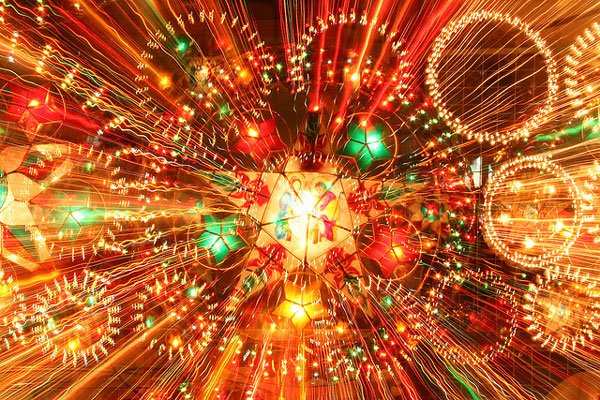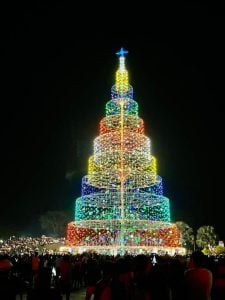Filipinos always find something to celebrate. During Christmastime, this celebratory attitude shines through in the parties, events and Philippine Christmas festivals. These festivals are mostly religious and centered on the child Jesus and the Holy Family. They have also become cultural celebrations, showcasing colorful traditions and customs.
You could say that the biggest Philippine Christmas festival is Christmas itself. Filipinos pride themselves in celebrating the longest and merriest Christmas holidays in the world. Christmas in the Philippines starts as early as September and extends through early January. This gives locals ample time to prepare for the actual festivities on December 25th and some celebrations in between.
There are a number of Philippine Christmas festivals you can witness and enjoy. They are scattered all over the country so be prepared to hop from cities to islands during this time.
San Fernando Giant Lantern Festival

The parol (star) serves as the most popular Christmas symbol in the Philippines. Filipinos hang the parol outside of homes to symbolize the star that guided the three wise men to Bethlehem. In San Fernando City, the parol becomes the center of festivities. Parol makers compete for the biggest and most outrageous parol at the start of the festival. People then display their entries throughout the province of Pampanga. The parol makes this one of the most spectacular Philippine Christmas festivals.
The Philippines export these extravagantly-designed stars to different parts of the world. This is so Filipinos can have a piece of home wherever they are.
Date: December 12
City: San Fernando, Pampanga
Maytinis Festival

Dubbed by the church as a true embodiment of the Christmas spirit, Cavite’s Maytinis Festival is a celebration to definitely witness. It is much like the Latin American Posadas — actors dressed as the Holy Family and other biblical characters parade through the streets of Kawit. People carry the characters on elaborate floats, reliving Joseph and Mary’s search for lodgings on Christmas Eve. Other provinces call this practice “panunuluyan”. Maytinis draws crowds out to the streets on Christmas Eve. After that, townspeople attend mass at the church where the parade ends.
Date: December 24
City: Kawit, Cavite
Niños Inocentes

Roman Catholics celebrate Niños Inocentes all over the world as a remembrance of the Holy Innocents. According to the bible, King Herod of Judea ordered all male children to be killed because he feared the birth of the new “king”. In the Philippines, locals treat the day much like April Fools — with pranks and practical jokes. For example, you can loan a person money on December 28 and never get it back on account of being the “innocent” one. Luckily, the Filipinos’ good sense of humor make them take these pranks in stride and happily play along.
Date: December 28
City: all over the Philippines
Torotot Festival

Davao City has a long-standing firecracker ban. As a resident of 30+ years, I do not remember seeing a fireworks display in at least 15 years. But this does not make the yuletide season less merry in the city. Davaoeños hold the Torotot Festival, a celebration with trumpets and horns used to make noise. It’s a superstitious belief — noise drives away the evil and ushers in the New Year. You can buy tororot (horns) in sidewalks, public markets and malls all over Davao City.
Date: December 31
City: Davao City
Bailes de Luces

Bailes de Luces translates to Dances of Lights, making this Philippine Christmas festival a unique celebration as it is held during nighttime. The Negrense town of La Castellana comes alive as dancers adorn the streets in costumes and props decked in LED lights. The festival celebrates the people’s dreams and aspirations for the coming year. Locals also hold the festival as a fitting end for the yuletide season.
Date: January 5
City: La Castellana, Negros Occidental
Feast of the Three Kings

The Christmas festivities in the Philippines officially end on the Feast of the Three Kings. Catholics celebrate it to remember the three wise men (kings) who traveled far to offer gifts of gold, frankincense and myrrh to the newborn Jesus. The feast is largely influenced by the Spanish who colonized the Philippine Islands for over three centuries.
Date: January 6
City: all over the Philippines
Feast of the Black Nazarene

The Feast of the Black Nazarene is technically not one of the Philippine Christmas festivals but it merits a mention since it is celebrated shortly after the yuletide season. This religious festival is very important to the Catholics and devotees from far and wide travel to Metro Manila to participate in Translacion. Devotees parade the image of the Black Nazarene through the streets leading to Quiapo church, its permanent home. People flock to the image, jostling to wipe their clothes and towels on it. They believe that the clothes, once rubbed on the image, become miraculous.
Trivia: The image of the kneeling Jesus of Nazareth was not originally black. It survived a fire in the galleon that carried it to the Philippines from Mexico. As a result, it arrived with a dark complexion hence the name Black Nazarene.
Date: January 9
City: Quiapo, Manila
Ati-Atihan

Another festival worth mentioning is Ati-Atihan. The festival is centered on Sto. Niño — one of the most venerated Catholic images in the Philippines. Aklanons celebrate this religious festival by parading through the streets of the city in elaborate costumes and their skins painted with soot. This is to imitate the Aetas, the first settlers of Panay Island, who had very dark skin. Originally a pagan festival, Ati-Atihan was once commemorated the friendship between the Aetas and the Borneans. When the Spaniards introduced Christianity, it became a Catholic celebration where revelers parade the image of the Sto. Niño.
Date: third Sunday of January
City: Kalibo, Aklan
Sinulog

Cebuanos celebrate the biggest Philippine festivals centered on the Sto. Niño. The Sinulog Festival also revolves the Sto. Niño. It is the first religious image brought by Ferdinand Magellan as a baptismal present to the leader of Cebu. To this day, millions of Catholics venerate the original image which is housed in a chapel at the Basilica Minore del Santo Niño de Cebu. Sinulog is a prayer-dance along the main streets of Cebu City. Upbeat music plays, oft punctuated with chants of “Viva Pit Senyor!” from the thousands of revelers. In addition, Sinulog involves elaborate costumes, cultural dance competitions and almost endless street parties.
Date: January 17
City: Cebu City
Filipinos are some of the merriest people you will meet. Even in the direst of times, they will always find something to celebrate. Christmas brings out this resilient attitude the most. As a result, there is almost no end to the celebrations during this season. Christmas is, indeed, the happiest time in the Philippines.





